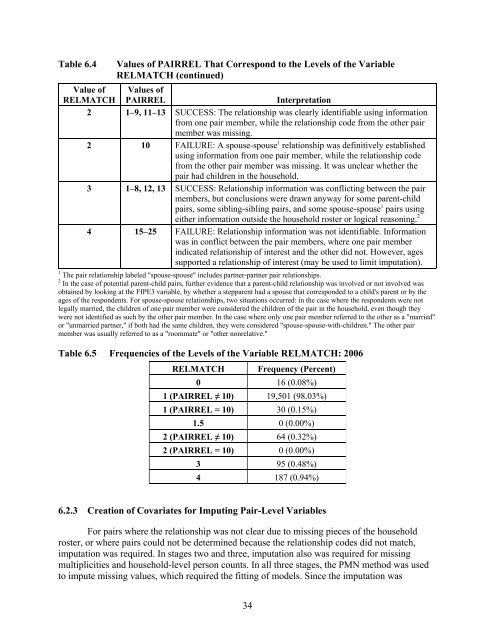Questionnaire Dwelling Unit-Level and Person Pair-Level Sampling ...
Questionnaire Dwelling Unit-Level and Person Pair-Level Sampling ...
Questionnaire Dwelling Unit-Level and Person Pair-Level Sampling ...
Create successful ePaper yourself
Turn your PDF publications into a flip-book with our unique Google optimized e-Paper software.
Table 6.4<br />
Value of<br />
RELMATCH<br />
Values of PAIRREL That Correspond to the <strong>Level</strong>s of the Variable<br />
RELMATCH (continued)<br />
Values of<br />
PAIRREL<br />
Interpretation<br />
2 1–9, 11–13 SUCCESS: The relationship was clearly identifiable using information<br />
from one pair member, while the relationship code from the other pair<br />
member was missing.<br />
2 10 FAILURE: A spouse-spouse 1 relationship was definitively established<br />
using information from one pair member, while the relationship code<br />
from the other pair member was missing. It was unclear whether the<br />
pair had children in the household.<br />
3 1–8, 12, 13 SUCCESS: Relationship information was conflicting between the pair<br />
members, but conclusions were drawn anyway for some parent-child<br />
pairs, some sibling-sibling pairs, <strong>and</strong> some spouse-spouse 1 pairs using<br />
either information outside the household roster or logical reasoning. 2<br />
4 15–25 FAILURE: Relationship information was not identifiable. Information<br />
was in conflict between the pair members, where one pair member<br />
indicated relationship of interest <strong>and</strong> the other did not. However, ages<br />
supported a relationship of interest (may be used to limit imputation).<br />
1 The pair relationship labeled "spouse-spouse" includes partner-partner pair relationships.<br />
2 In the case of potential parent-child pairs, further evidence that a parent-child relationship was involved or not involved was<br />
obtained by looking at the FIPE3 variable, by whether a stepparent had a spouse that corresponded to a child's parent or by the<br />
ages of the respondents. For spouse-spouse relationships, two situations occurred: in the case where the respondents were not<br />
legally married, the children of one pair member were considered the children of the pair in the household, even though they<br />
were not identified as such by the other pair member. In the case where only one pair member referred to the other as a "married"<br />
or "unmarried partner," if both had the same children, they were considered "spouse-spouse-with-children." The other pair<br />
member was usually referred to as a "roommate" or "other nonrelative."<br />
Table 6.5 Frequencies of the <strong>Level</strong>s of the Variable RELMATCH: 2006<br />
RELMATCH<br />
Frequency (Percent)<br />
0 16 (0.08%)<br />
1 (PAIRREL ≠ 10) 19,501 (98.03%)<br />
1 (PAIRREL = 10) 30 (0.15%)<br />
1.5 0 (0.00%)<br />
2 (PAIRREL ≠ 10) 64 (0.32%)<br />
2 (PAIRREL = 10) 0 (0.00%)<br />
3 95 (0.48%)<br />
4 187 (0.94%)<br />
6.2.3 Creation of Covariates for Imputing <strong>Pair</strong>-<strong>Level</strong> Variables<br />
For pairs where the relationship was not clear due to missing pieces of the household<br />
roster, or where pairs could not be determined because the relationship codes did not match,<br />
imputation was required. In stages two <strong>and</strong> three, imputation also was required for missing<br />
multiplicities <strong>and</strong> household-level person counts. In all three stages, the PMN method was used<br />
to impute missing values, which required the fitting of models. Since the imputation was<br />
34
















